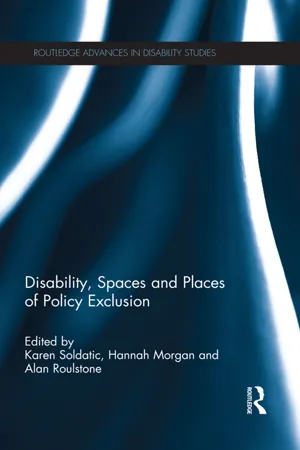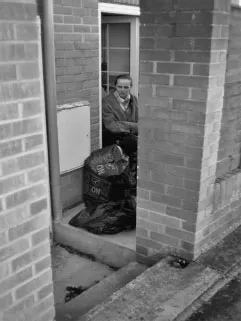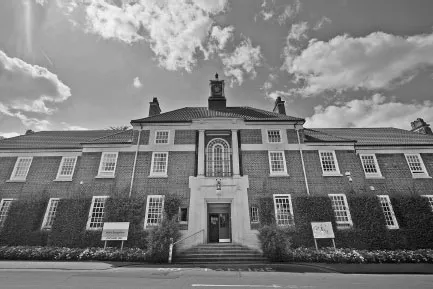![]()
Part I
Conceptualising disability
Spaces and places of policy exclusion
![]()
1 Space, place and policy regimes
The changing contours of disability and citizenship
Rob Imrie
Introduction
Far from my body being for me no more than a fragment of space there would be no space at all for me if I had no body.
(Merleau-Ponty, 2002: 117)
A significant and persistent characteristic of society is disabling spaces that are rarely sensitised to the needs of disabled people. These range from environments that do not provide easy means of entry to buildings for people with mobility impairments, to places that rarely consider the importance of clear, communicable, signage to facilitate the navigation of people with sensory impairment (see Emery, 2009; Saerberg, 2010). More often than not, designed environments revolve around a spatial logic that separates people by virtue of their bodily differences and variations in cognitive and physiological capabilities. Such separations are tantamount to an infringement of disabled people’s liberties, and curtail, potentially, their rights to occupy, and to inhabit and be present in, everyday places, the use of which is intrinsic to a person’s realisation of their well-being (Edwards, 2013; Edwards and Imrie, 2008).
Such realisation highlights the interdependence between the body and space, and the importance of geographical relationships in shaping a person’s embodiment or their being in the world (see Merleau-Ponty, 2002; Relph, 1976). To be embodied, as we all are, is to be emplaced spatially, and disabled people’s emplacement is crafted by disabling spatialities or encounters in/through space that reinforce the socio-cultural marginalisation of those deemed to be impaired. The facts of such marginalisation are well documented, and are illustrative of disabled people’s lack of power to shape their living spaces, or to redress, with any ease, manifold forms of spatial injustice. This is characterised by a denial of access to, and occupation of, place, by virtue of impairment, a state of social exclusion, or what Walker and Walker (1997: 8) define as ‘the denial (or non-realization) of the civil, political, and social rights of citizenship’ (see also Room, 1995).
The denial and/or non-realisation of rights to space, that is, curtailment of capacities to exercise self-determination, is intertwined with socio-legal systems that define the parameters of citizenship, or what one’s entitlements are within the context of state policy. The prevailing context is austerity that, since 2008, has revolved around a familiar menu of retrenchment of state expenditures, privatisation and deregulation, and is implicated in what the editors of this book describe as changes in ‘the social relations of space and place’. In the chapter, I explore this statement and the multiple intersections between disability, austerity public policy and geography, noting the limited explication about the interrelationships between the lives of disabled people and the geographies of public policy, or the intrinsically spatialised nature of state policy regimes. I suggest that the development of interdisciplinary inquiry, between geography, social policy and disability studies, may be a basis for enhancing understanding of the impact of policy regimes on disabled people.
I divide the chapter into three parts. I begin by outlining the case for the focus on the inherently geographical nature of policy regimes in which, as I shall argue, the fortunes of disabled people have to be understood as indissoluble from the intersections between space, place and policy. Such intersections, in the context of a post-welfare world, are shaped, in part, by the human worthiness of disabled people being, increasingly, discredited in a context whereby welfare policy reform is placing the onus on self-active and self-starting individuals as the basis of a good society. I develop this discussion in the second part of the chapter where I focus on the diminution of disabled people’s liberties with reference to place-based restructuring in three different policy domains in the UK, housing, transport and public space. In each instance, public policy is intersecting with place to recreate spaces of exclusion or environs that deny opportunity for selfhood.
I conclude the chapter by outlining the need to (re-)politicise the body as part of the development of what citizenship is or ought to be, in ways whereby impairment becomes regarded as the normalcy of everyday life. The assertion, of the normalcy of impairment, does, however, challenge the socio-cultural constructions of disability in society, including the crafting of disabling spatialities that render, potentially, impairment as an object of disablement. I suggest that these relations (of disablement) may be challenged by the development of a body politics that develops the discourse that everyone, irrespective of corporal form and performance, has the rights to inhabit, or to be emplaced, in ways whereby spaces are facilitative of a person’s autonomy or the intrinsic value of the self.
Policy regimes, citizenship and productive bodies
This volume is part of a new wave of writings seeking to understand the interrelationships between disability, space and public policy, and to re-direct study towards the irreducible, intersectional, nature of disablement in society. Such intersections conceive of disability as a relational phenomenon, multi-dimensional in scope, and constituted through competing discourses about embodiment. The most significant is the ‘body-abject’ or the elision between impairment and personal deficiency, a pejorative representation of disability that medicalises and individualises the body. Social practice towards the deficient body sifts and sorts people by bodily capabilities and capacities in relation to measures of fitness to work. Such measures, while seemingly objective, are neither neutral nor benign and are the basis of moral judgments about who are worthy, rational, subjects. Those deemed to deviate from such subject-positions are targets of state interventions to correct deviancy and provide support for self-improvement.
The social practices of disablement, that constitute the basis of disabled people’s citizenship, are influenced by where they take place, that is, their particular geographical or spatial contexts (Imrie and Edwards, 2007). Disablement, as a political ideology and practice towards disabled people, is not impervious to the locales or places in which disabled people lead their lives, and one of the key arguments of the book is that place matters, not only as the context of/for embodied social practice, but, more importantly, as constitutive of those very practices (Massey, 2005). The structures and possibilities of experience, that is, the shaping of one’s identity, is intertwined with space, not in any essentialist way that would ask the question ‘who am I?’, but, rather, where the social and the spatial are conceived as indivisible, in which one’s positioning in socially defined space is characterised by asking the question ‘where am I?’.
The understanding of disability as a spatial phenomenon, is, however, relatively underdeveloped. Within the discipline of geography, there is a small corpus of research on the subject, characterised by its marginality at international conferences, in geographical journals and textbooks. In a major geographical textbook, published in 2011, there are no references to, or comments about, disability, despite the authors writing a chapter about the body, place and identity (Nayak and Jeffrey, 2011). This situation is more common than not. Equally, it is rare to find writings in sociological and social policy journals that consider the geographies of disability. For instance, the 2012 Disability and Society conference featured a single article by a geographer on a non-geographical theme, and few articles with a geographical or spatial focus. In the 2011 and 2012 issues of Disability and Society, one article, from 44 that were published, was written by a geographer.
This need not matter if there was evidence of sustained interest in, and development of, the embodied geographies of disability, or a research disposition that recognised, after Zola (1989), that impairment is intrinsic to the human condition (see also Bickenbach and Cieza, 2011). This is not so, yet, for Zola (1989), impairment is normal and omnipresent, and this fact of matter makes it incumbent on scholarship to acknowledge how impairment, as an object of disablement, is constructed in and through its socialisation in space. This point is pertinent in relation to the social model of disability that tends to present an over-socialised understanding of disability, in which space, and disabling spatialities, are rarely articulated or part of theoretical focus. Where space is broached by the social model it appears to be as a backdrop to social actions, no more than a container that has effects on the objects contained within it.
In contrast, geographers such as Doreen Massey (2005) note that the social and the spatial are mutually entwined and constitutive insofar as social relationships and processes cannot exist outside of space. For Massey (2005), the social and the spatial are constituted in and through particular place-based social structures or what she refers to as ‘spatialities’. Here, space, as part of a process in the making of place, is relational, not stable or fixed, or local or bounded. Instead, it is produced and producing, imagined and materialised, structured and lived, relational, relative and absolute. Wigley (1992), drawing on De Certeau (1984), suggests that space is not a prior condition of something else but, rather, it is an outcome of part of a process of making the thing or entity we call place. In De Certeau’s (1984: 117) terms, ‘space is a practised place’ or what Mudimbe (1991: 169) describes as ‘a geography constituted by dynamic elements which meet, intersect, unite, cross each other, or diverge’.
Figure 1.1 Ann, one of my research subjects from a project in the early 2000s, shows how the normal design of the dwelling does not permit her to move from the back door to the side passage where she has to deposit her weekly rubbish for collection. The design prevents her from engaging in an everyday household activity.
These views point towards the need to consider what the relationship is between the role of disability in the discourse of space, and the role of space in the discourse of disability. The active, often purposive, production of bodily distinctions around disabled/abled can be identified in all facets of spatial discourse (see Gleeson, 1999; Hansen and Philo, 2007). This is evident in the physical design of any designed artefact in which there is complicity of the spatial discourse with a general, socio-cultural, subordination of impairment. Figure 1.1 shows an all too typical situation in which the space is literally producing the effect of disability (see also Edwards, 2013). It is characterised by an inequality of treatment of those whose bodies are unable to conform to the spatialities of the ‘body-normal’. The outcome, disablement, is illustrative of the power of disabling design discourse as a naturalistic part of the crafting of the designed environment and, as such, it is rarely problematised or subject to critique.
The manifold nature of disabling spatialities, and their more or less taken-for-granted nature, makes it incumbent on scholarship not only to consider how impairment is manifest in space, but how space is invested with matter inimical to individuals with impairment (Freund, 2001; Gleeson, 1999; Imrie, 1996; Vellani, 2013). Such matter, from thoughtless design that prevents ease of access to places, to negative representations of disabled people that reinforce a sense of the abnormality of impairment, are intertwined with the governance of the subject, or the ways in which disabled people are defined by the state as citizens. For disabled people, their rights to be, to inhabit, or occupy space, are dependent, in part, on socio-legal principles that, through their application via state policy, are implicated in the production of disabling spaces, or spatialities that render disabled people as less than full citizens (see Vellani, 2013).
These interrelationships between geography and public policy, in the production of socio-spatial demarcations or exclusions from society, form the bedrock of written histories about disability (see Davis, 1995; Nielsen, 2012). For instance, Susan Schweik’s (2010) important book, on the Ugly Laws in the United States, describes the use of local ordinances as socio-legal instruments to keep places free from the presence of particular categories of disabled people. As Schweik (2010) suggests, the laws were part of a broader societal concern with policing identities and the meaning of the body. Policing, as part of the exercise of state power, was also a feature of disabled people’s incarceration into special places or locales, ranging from spaces for schooling, to asylums and dedicated work environs (see Figure 1.2). Such settings, as segregated spaces, were places for social control, to contain, and discipline, ‘not normal’ bodies, and to manage the presence of disabled people in everyday, mainstream, society.
While some of the more extreme versions of the state’s policing of impairment have disappeared, contemporary public policy is no less likely to be implicated in disabled people’s marginalisation from, and political activism in relation to, particular locales or sites of social interaction. The central thrust of this book is the understanding that, since the late twentieth century, there has been a resurgence of (neo-)liberalising government, in which experimental forms of governance, encouraging the development of post-welfare citizenship regimes, have emerged. Such regimes include the diminution of public expenditure, the retrenchment of public services, and the reduction of state interventions in the regulation of socio-institutional relations. The emphasis is one whereby citizens are required to depend less on the state for support, and to self-activate and fend for themselves by deployment of their own capabilities and resources.
This logic would have some credibility if only there was equity of capability and access to resources. For many disabled people this is not so, and their ability to cope, and influence access to life opportunities, is constrained by disabling socio-spatial formations, including the crafting of policy regimes around conceptions of corporeality that do not articulate, or recognise, the differentiated nature of bodies. Rather, neo-liberalising citizenship is premised on the undifferentiated nature of the self, or the individual defined by their relationship to market-based norms, i.e. citizenship as the exercise of individual economic agency. The difficulty for disabled people is that this instrumental logic does not equate to, or recognise, their varied and heterogeneous subject positions, or acknowledge their margin-ality in relation to partaking in market, exchange, relations.
Figure 1.2 Spacing control and the governance of disability: Bethlem Royal Hospital, London.
Source: http://en.wikipedia.org/wiki/File:Bethlem_Royal_Hospital_Main_building_view_1.webp.
The spatialisation of policy and disability
In this part of the chapter, I consider the intersections between space and policy in the lives of disabled people in the UK, and I develop the understanding that neo-liberal values are shaping the (re-)production of disabling spaces that serve to perpetuate the ‘not normal’ body as an aberration or a thing that resides at the margins of citizenship. These margins can be defined in terms of the relative lack of autonomy of disabled people that may suppress their sociability, or what Arendt (1958) refers to as the quality of life in civil society and civic associations. Disabled people’s abilities to express autonomy is cons...


